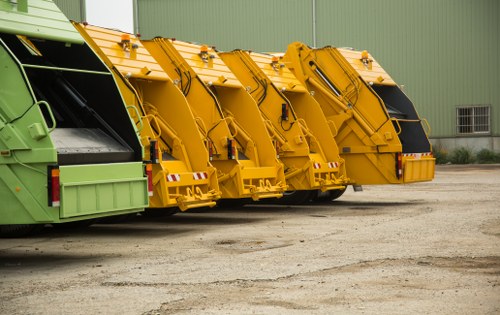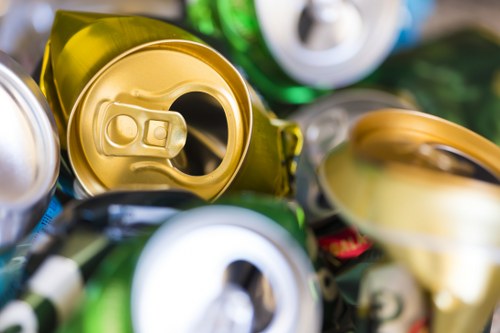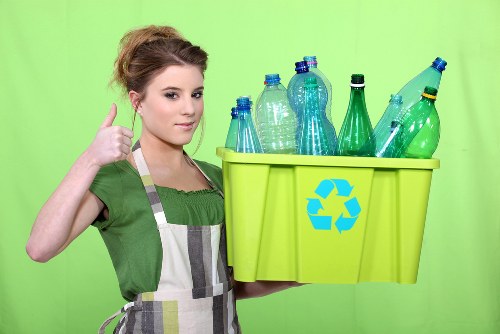Comprehensive Guide to Construction Waste Clearance in Kilburn
Understanding Construction Waste Clearance

Construction projects, big or small, inevitably produce a significant amount of waste. Proper construction waste clearance is essential to ensure that your project runs smoothly, remains compliant with local regulations, and minimizes its environmental impact. In Kilburn, efficient waste management has become a critical service for both residential and commercial construction activities.
Managing construction waste involves the collection, removal, and recycling or disposal of materials such as concrete, wood, metals, and other debris. Effective waste clearance not only keeps the construction site safe and organized but also promotes sustainability by reducing landfill usage.
Choosing the right waste clearance service in Kilburn can make a significant difference in the success of your construction project. It’s important to understand the process, benefits, and best practices to ensure you’re making informed decisions.
Why Proper Waste Clearance Matters

Proper waste clearance is vital for several reasons:
- Legal Compliance: Adhering to local waste disposal regulations in Kilburn helps avoid fines and legal issues.
- Environmental Protection: Proper disposal and recycling reduce the environmental footprint of construction activities.
- Safety: Clearing waste from the site minimizes hazards for workers and visitors.
- Efficiency: Organized sites enhance productivity and streamline construction processes.
Neglecting waste clearance can lead to overwhelmed disposal sites, increased costs, and a negative impact on the surrounding community.
By implementing a robust waste management plan, construction companies can ensure smooth operations and contribute positively to Kilburn’s sustainability goals.
Types of Construction Waste

Construction waste can be categorized into several types, each requiring specific handling and disposal methods:
- Concrete and Masonry: Includes broken bricks, blocks, and concrete slabs.
- Wood and Timber: From framing materials to packaging.
- Metals: Such as steel beams, aluminum, and copper wiring.
- Plastics: Including pipes, fittings, and packaging materials.
- Drywall: Sheets of gypsum board used in interior construction.
- Miscellaneous Debris: Includes packaging, insulation, and other residual materials.
Understanding the types of waste generated helps in planning effective clearance and recycling strategies, ensuring minimal environmental impact.
Proper sorting and categorization at the site can enhance recycling efforts and reduce the amount of waste sent to landfills.
Benefits of Professional Waste Clearance Services

Engaging professional waste clearance services in Kilburn offers numerous advantages:
- Expertise: Professionals are knowledgeable about the best practices and legal requirements for waste disposal.
- Efficiency: Experienced teams can quickly and effectively clear waste, minimizing project delays.
- Cost-Effective: Avoiding improper disposal can save money by preventing fines and reducing landfill fees.
- Sustainability: Professionals can identify materials suitable for recycling, promoting environmentally friendly practices.
- Safety: Trained personnel ensure that waste is handled and removed safely, reducing site hazards.
Investing in professional services ensures that waste clearance is handled systematically, allowing you to focus on other aspects of your construction project.
Moreover, reputable waste clearance companies often provide additional services such as site clean-up and ongoing waste management solutions.
Steps Involved in Construction Waste Clearance

The process of construction waste clearance typically involves several key steps to ensure efficiency and compliance:
- Assessment: Evaluating the types and volume of waste generated in the construction project.
- Planning: Developing a waste management plan that outlines collection, sorting, and disposal methods.
- Collection: Gathering waste materials from the site using appropriate equipment.
- Sorting: Separating recyclable materials from non-recyclables to maximize resource recovery.
- Transportation: Safely transporting the waste to designated recycling centers or disposal facilities.
- Disposal: Disposing of residual waste in compliance with environmental regulations.
Each step must be executed with attention to detail to ensure that waste is managed responsibly and efficiently.
Implementing these steps systematically helps in maintaining an organized site and promotes environmentally conscious construction practices.
Recycling and Reuse of Construction Waste
Recycling is a cornerstone of sustainable construction practices. By recycling materials like concrete, wood, and metals, construction projects can significantly reduce their environmental impact.
- Concrete: Crushed concrete can be reused as aggregate in new construction or as a base for roads.
- Wood: Recycled wood can be repurposed for new construction, landscaping, or as fuel.
- Metals: Metals retain their value and can be melted down and reused without degradation.
- Plastics: Certain plastics can be recycled into new building materials or products.
Reusing materials not only conserves resources but also reduces the need for new raw materials, leading to cost savings and environmental benefits.
Implementing a robust recycling program within your waste clearance plan can contribute to Kilburn’s sustainability initiatives and position your project as environmentally responsible.
Emphasizing recycling and reuse ensures that construction projects are not only efficient but also align with global efforts to reduce waste and promote sustainability.
Choosing the Right Waste Clearance Company in Kilburn
Selecting the appropriate waste clearance company is crucial for the success of your construction project. Here are key factors to consider:
- Reputation: Look for companies with positive reviews and a proven track record in Kilburn.
- Licensing: Ensure the company is properly licensed and compliant with local regulations.
- Services Offered: Check if they provide comprehensive services that meet your specific needs.
- Pricing: Compare quotes from multiple companies to find cost-effective solutions without compromising quality.
- Flexibility: A company that can adapt to your project’s schedule and scope changes is valuable.
- Environmental Practices: Choose companies that prioritize recycling and sustainable disposal methods.
Thoroughly evaluating these factors will help you select a reliable and efficient waste clearance partner in Kilburn.
Engaging the right company ensures that waste management is handled professionally, allowing your project to proceed without unnecessary interruptions or complications.
Cost Factors in Construction Waste Clearance
The cost of construction waste clearance can vary based on several factors:
- Volume of Waste: Larger projects generate more waste, increasing disposal costs.
- Type of Materials: Some materials require special handling or recycling, which can affect pricing.
- Location: Accessibility of the site in Kilburn may influence transportation costs.
- Service Frequency: Regular clearance services may offer better rates compared to one-time pickups.
- Additional Services: Services like sorting, recycling, and site clean-up can add to the overall cost.
Understanding these cost factors can help you budget effectively and choose services that offer the best value for your investment.
Discussing your project’s specific needs with waste clearance providers can lead to tailored solutions that align with your financial parameters.
Regulations and Compliance in Kilburn
Adhering to local waste disposal regulations is essential for construction projects in Kilburn. Non-compliance can result in hefty fines and project delays.
- Waste Classification: Understanding the different categories of waste and their specific disposal requirements.
- Permits: Obtaining necessary permits for waste transportation and disposal.
- Record-Keeping: Maintaining accurate records of waste types, quantities, and disposal methods.
- Environmental Standards: Ensuring that waste disposal practices meet environmental protection standards.
Working with a professional waste clearance company ensures that all regulatory requirements are met, safeguarding your project from legal complications.
Staying informed about local regulations and updates in waste management policies is crucial for long-term compliance and sustainability.
Innovative Solutions in Waste Clearance
The waste management industry is continuously evolving with innovative solutions aimed at improving efficiency and sustainability.
- Advanced Sorting Technology: Automated systems enhance the accuracy and speed of waste sorting.
- Digital Tracking: Utilizing software to monitor waste flow and ensure compliance with regulations.
- Eco-Friendly Disposal Methods: Implementing practices that minimize environmental impact, such as composting and energy recovery.
- Modular Waste Containers: Flexible container options that cater to different project sizes and types.
- Integration with Construction Management: Coordinating waste clearance seamlessly with overall project timelines and workflows.
Embracing these innovative solutions can significantly enhance the effectiveness of your waste clearance strategy, leading to better project outcomes.
Staying ahead with the latest technologies ensures that your construction project remains efficient and environmentally responsible.
Environmental Impact of Construction Waste
Construction waste has a considerable impact on the environment if not managed properly. The following points highlight these effects:
- Landfill Overuse: Excessive waste leads to overcrowded landfills, which can result in soil and water contamination.
- Resource Depletion: Discarding valuable materials contributes to the depletion of natural resources needed for new construction.
- Carbon Footprint: Improper waste management increases greenhouse gas emissions from decomposing organic materials and transportation of waste.
- Habitat Destruction: Waste disposal sites can disrupt local ecosystems and wildlife habitats.
By implementing effective waste clearance and recycling practices, construction projects can mitigate these negative environmental impacts.
Promoting sustainable waste management not only benefits the environment but also enhances the reputation of your construction business in Kilburn.
Future Trends in Construction Waste Management
The future of construction waste clearance is poised to embrace more sustainable and technologically advanced practices.
- Circular Economy: Shifting towards reuse and recycling to create a closed-loop system where materials are continuously repurposed.
- Smart Waste Management: Leveraging IoT and AI to optimize waste collection and processing.
- Green Building Certifications: Meeting standards that require stringent waste management practices.
- Biodegradable Materials: Developing and using materials that decompose naturally, reducing the burden on waste disposal systems.
- Collaborative Platforms: Facilitating better coordination between various stakeholders involved in waste management.
Staying informed about these trends will help construction companies in Kilburn adapt and implement forward-thinking waste management strategies.
Embracing future trends ensures long-term sustainability and efficiency in waste clearance processes.
Case Studies: Successful Waste Clearance in Kilburn
Examining successful waste clearance projects in Kilburn provides valuable insights into best practices and effective strategies.
- Project A: A commercial building project that implemented a comprehensive recycling plan, reducing landfill waste by 60%.
- Project B: A residential development that utilized on-site sorting to streamline waste removal and enhance recycling rates.
- Project C: An infrastructure project that partnered with local waste management companies to ensure timely and compliant waste disposal.
These case studies highlight the importance of strategic planning, collaboration, and the adoption of sustainable practices in achieving successful waste clearance.
Learning from these examples can guide your construction project towards more efficient and environmentally responsible waste management.
Implementing a Waste Management Plan
Creating an effective waste management plan is essential for successful construction waste clearance. Here are the key components:
- Waste Audit: Conducting a thorough assessment of the types and quantities of waste your project will generate.
- Set Goals: Defining clear objectives for waste reduction, recycling, and disposal.
- Allocate Resources: Ensuring adequate materials and personnel are available for waste management tasks.
- Develop Procedures: Establishing protocols for waste collection, sorting, transportation, and disposal.
- Training: Educating staff and workers on proper waste handling and safety measures.
- Monitoring and Evaluation: Regularly reviewing the waste management plan’s effectiveness and making necessary adjustments.
By implementing these components, construction projects in Kilburn can achieve efficient and compliant waste clearance.
A well-structured waste management plan not only facilitates smooth operations but also promotes a culture of sustainability within the construction team.
Technological Tools for Waste Management
Leveraging technology can significantly enhance the efficiency of waste clearance processes. Some of the key tools include:
- Waste Tracking Software: Helps in monitoring waste generation, collection, and disposal.
- Automated Sorting Systems: Improves the accuracy and speed of waste material separation.
- GPS Fleet Management: Optimizes the routing and scheduling of waste collection vehicles.
- Mobile Apps: Enables real-time communication and coordination among waste management teams.
- Data Analytics: Provides insights into waste patterns and helps in making informed decisions.
Integrating these technological tools into your waste clearance strategy can enhance efficiency, reduce costs, and improve overall sustainability.
Embracing digital solutions ensures that your construction waste management remains modern, effective, and adaptable to changing project needs.
Sustainability and Waste Clearance
Sustainability is at the heart of modern construction practices. Effective waste clearance contributes to sustainability by reducing resource consumption and minimizing environmental impact.
- Resource Efficiency: Recycling materials reduces the need for new resources, conserving natural reserves.
- Energy Conservation: Producing recycled materials often consumes less energy compared to manufacturing new ones.
- Reduced Emissions: Proper waste management lowers greenhouse gas emissions from landfills and waste processing.
- Community Health: Minimizing waste leads to cleaner environments, benefiting local communities.
Incorporating sustainable waste clearance practices not only benefits the environment but also enhances the reputation and marketability of your construction projects.
Commitment to sustainability fosters long-term success and aligns with global efforts to combat environmental challenges.
Tips for Effective Waste Clearance
Implementing effective strategies can greatly improve your waste clearance efforts in Kilburn.
- Plan Ahead: Incorporate waste management into the early stages of project planning.
- Educate Your Team: Ensure everyone understands the importance of proper waste handling and their role in it.
- Use the Right Containers: Provide appropriate bins and containers for different types of waste.
- Regular Pickup Schedule: Establish a consistent schedule for waste collection to prevent accumulation.
- Monitor Progress: Keep track of waste metrics to identify areas for improvement.
- Engage Stakeholders: Collaborate with suppliers and subcontractors to minimize waste generation.
Adhering to these tips can streamline your waste clearance process, making it more efficient and effective.
Proactive waste management leads to smoother operations and fosters a culture of responsibility and sustainability within your construction projects.
Conclusion
Construction waste clearance is a critical component of any construction project in Kilburn. By understanding the types of waste, the importance of proper disposal, and the benefits of professional services, you can ensure your project remains efficient, compliant, and environmentally responsible.
Implementing effective waste management strategies not only enhances operational efficiency but also contributes to sustainability and community well-being. Embrace the best practices and innovative solutions to make your construction projects successful and eco-friendly.
Ready to streamline your construction waste clearance? Contact us today to learn how our expert services can support your project’s needs.